Google Chrome continues its reign as the undisputed champion of web browsers. With a massive user base and an ever-expanding suite of features, Chrome isn’t just a browser; it’s an internet ecosystem.
If you’re looking to understand Chrome’s dominance, its impact on the digital world, and how you can leverage its capabilities, you’ve come to the right place.
This article dives deep into the Google Chrome statistics 2025, offering detailed insights in plain English, packed with the latest information and answers to your burning questions.
Table of Contents
ToggleChrome: The Global Powerhouse
Imagine nearly two-thirds of all internet users choosing one specific pathway to the web – that’s the reality for Google Chrome. It stands as the leading browser worldwide, and by 2025, its influence will only grow.
Today, an astounding 3.98 billion internet users actively choose Chrome over any other browser. This isn’t just a number; it represents a significant portion of humanity’s digital interactions.
Let’s break down the key figures that define Chrome’s monumental presence.
Chrome Statistics 2026: Top Picks at a Glance
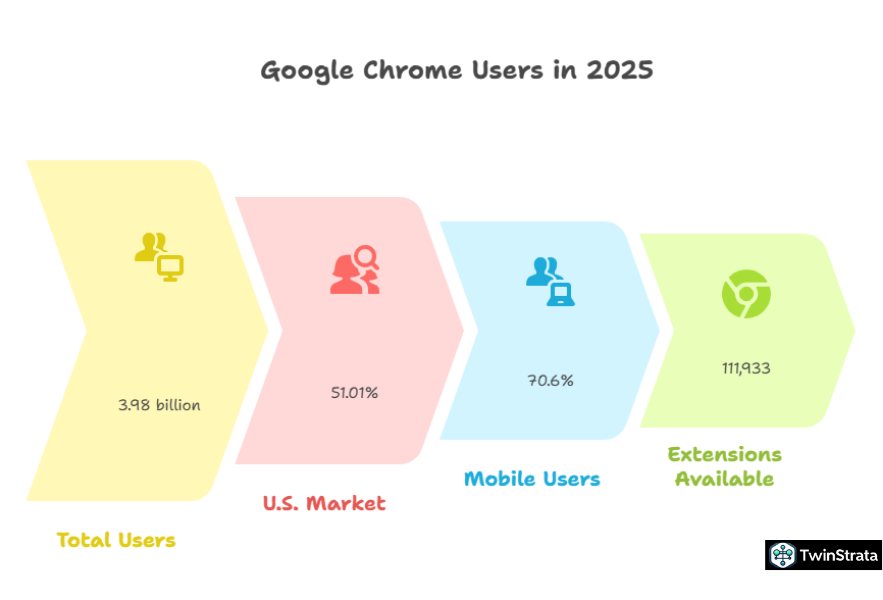
- 3.98 billion people worldwide use Chrome. This incredible figure highlights its universal appeal and widespread adoption.
- Chrome captures 70.5% of the global browser market share. This means that out of every ten internet users, seven are likely browsing with Chrome.
- In the United States, Chrome maintains a strong lead, holding 51.01% of the browser market share. Even in a diverse market, Chrome remains the top choice.
- The browser truly dominates the mobile landscape, commanding 70.6% of the mobile browser market share. Your phone is very likely running Chrome.
- Chrome for Android is the most popular version, with a staggering 40.58% of the browser market share. This speaks to the sheer volume of Android devices globally.
- The Chrome Web Store boasts 111,933 Chrome extensions, offering a vast array of tools to enhance your browsing experience.
Also read about: Internet Usage Statistics
How Many People Use Chrome? A Closer Look
The internet population is enormous, with over 5.65 billion users. Out of this vast number, approximately 3.98 billion individuals actively use Chrome. This signifies an impressive growth trend.
Compared to 3.06 billion users in 2020, Chrome has added nearly 1 billion users in just five years, showcasing a remarkable growth rate of 44.35% since 2018. This continuous expansion underscores Chrome’s ability to attract and retain users globally.
Table: Number Of Chrome Users by Year
| Year | Number Of Users |
| 2025* | 3.98 billion |
| 2023* | 3.45 billion |
| 2022* | 3.3 billion |
| 2021 | 3.23 billion |
| 2020 | 3.06 billion |
| 2019 | 2.74 billion |
| 2018 | 2.39 billion |
| 2017 | 2.04 billion |
| 2016 | 1.84 billion |
Source: Statista
Chrome Market Share: A Story of Dominance
Chrome not only holds the leading position but also actively increases its lead in the global browser market. With a commanding market share of 70.5%, it leaves its competitors far behind.
Safari, largely due to its integration with Apple’s ecosystem, ranks second with 14% of the market share. Microsoft Edge, a relatively newer contender, has impressively surpassed Firefox, accounting for 5.15% of the browser market.
Table: Worldwide Browser Market Share in 2025 (All Platforms)
Chrome’s market share has not just held steady; it has experienced significant growth. Moving from 65.72% in 2024 to 70.5% in 2025, this indicates an accelerating global adoption of the browser. This upward trend solidifies Chrome’s position as the go-to choice for internet users.
Table: Chrome’s Browser Market Share by Year
| Year | Chrome’s Market Share |
| 2025 | 70.5% |
| 2024 | 65.72% |
| 2023 | 63.87% |
| 2022 | 64.68% |
| 2021 | 63.8% |
| 2020 | 63.38% |
| 2019 | 63.62% |
| 2018 | 62.28% |
| 2017 | 55.04% |
| 2016 | 51.06% |
Source: StatCounter
Chrome US Market Share: A Strong Home Front
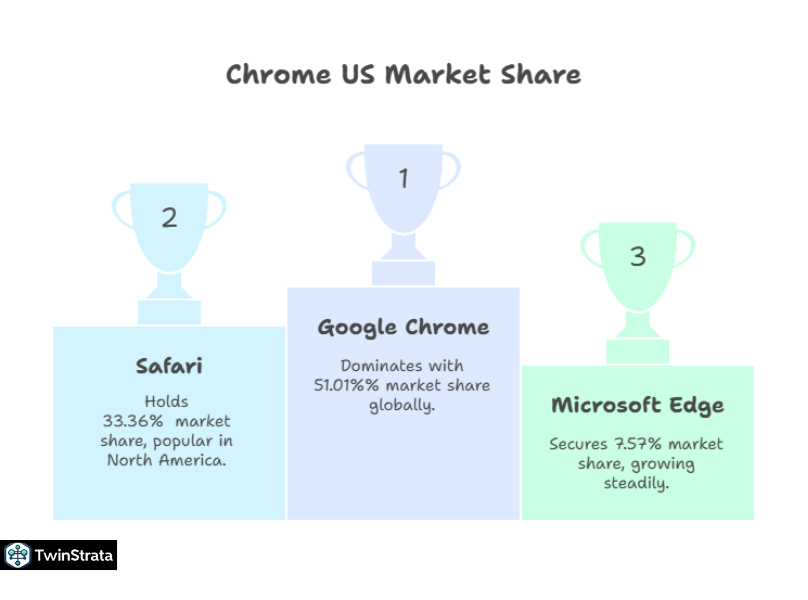
In its home country, Chrome continues to be the dominant force. It accounts for an impressive 51.01% of the browser market share in the United States, showcasing its widespread popularity among American users.
Safari remains its closest competitor at 33.36% of the market share, largely due to the prevalence of Apple devices.
Table: US Browser Market Share of the Most Popular Browsers
| Browser | Chrome Market Share In US |
| Chrome | 51.01% |
| Safari | 33.36% |
| Edge | 7.57% |
| Firefox | 4.14% |
| Samsung Internet | 1.62% |
| Opera | 1.01% |
- Also read about: Google Search Statistics
Chrome Usage Statistics: More Than Just Numbers

Chrome’s journey of gaining new users has been consistent and impressive. We are now reviewing all the key statistics that paint a clear picture of Chrome’s usage patterns.
Did you know that the largest number of Chrome users in the United States resides in Wyoming?
Data from True List indicates that a remarkable 65.94% of internet users in Wyoming prefer Chrome. Florida follows, with 37.15% of its users opting for Chrome. This regional variation highlights interesting user preferences across states.
Table: Top Five US States with the Highest Number of Chrome Users
| State | Percentage of Chrome Users |
| Wyoming | 65.94% |
| Florida | 37.15% |
| New Mexico | 36.92% |
| Connecticut | 36.75% |
| Alabama | 36.64% |
Beyond geographical distribution, Chrome holds a significant place in the hearts of its users. A survey reveals that 6% of people in the United States consider Chrome the app they could least do without.
This places Chrome 6th on the list of most essential apps for Americans, trailing behind powerhouses like Facebook (17%) and Twitter (5th place). This statistic truly reflects the integral role Chrome plays in daily digital lives.
Chrome Devices Statistics: Dominance Across Screens
Chrome’s market share cleverly adapts and often dominates across different devices. In this section, we examine key statistics on Chrome’s browser market across mobile, desktop, and tablet devices.
Chrome Mobile Statistics: On the Go
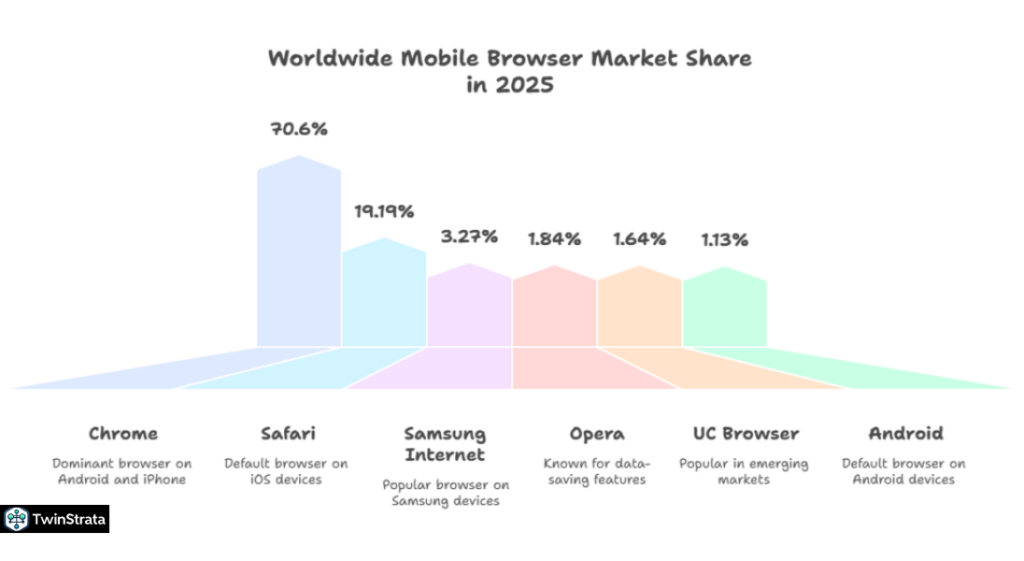
Globally, Chrome firmly holds the lead in the mobile browser market with a staggering 70.6% share. Safari trails behind, largely thanks to its default status on iOS devices, holding 19.19% of the market. This clearly shows that whether you are on an Android or even an iPhone, Chrome is a top choice for mobile browsing.
Table: Worldwide Mobile Browser Market Share in 2025:
| Browsers | Mobile Browser Market Share |
| Chrome | 70.6% |
| Safari | 19.19% |
| Samsung Internet | 3.27% |
| Opera | 1.84% |
| UC Browser | 1.64% |
| Android | 1.13% |
Source: Debugbear
Also read about: Mobile Internet Traffic Statistics
Chrome Desktop Statistics: The Home Base
On desktop computers, Chrome continues its global leadership, holding an impressive 71.17% share worldwide. This means that for serious work or casual browsing on a PC or Mac, Chrome is the primary choice for most users.
Recent data confirms Chrome’s unwavering dominance, with Microsoft Edge coming in second at 11.92%, showing it’s gaining ground but still far from challenging Chrome’s top spot.
Table: Desktop Browser Market Share in 2025:
| Browser | Market Share |
| Chrome | 71.17% |
| Edge | 11.92% |
| Safari | 6.01% |
| Firefox | 4.72% |
| Opera | 1.84% |
How Many Chrome Extensions Are There? Customizing Your Experience
One of Chrome’s most powerful features is its extensibility. The latest data reveals that there are 111,933 Chrome extensions available on the Chrome Web Store.
While pinpointing the exact, constantly changing number can be a challenge, it’s clear that the vast majority of these extensions, over half, fall under the productivity category. This highlights users’ desire to tailor their browsing experience for efficiency and enhanced workflow.
Chrome Web Store Statistics: Apps and Ratings
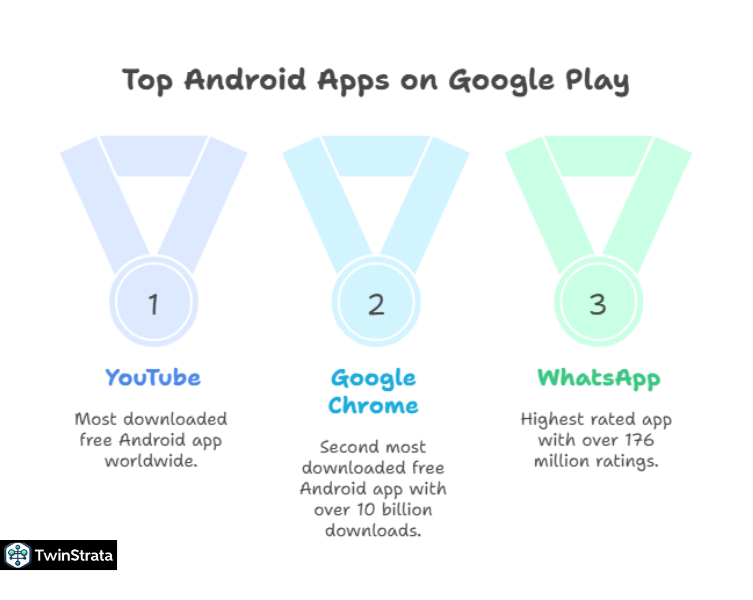
The Chrome Web Store is a vibrant marketplace, offering more than just extensions. It’s also where you find the Chrome app itself. Let’s explore some key statistics about Chrome’s ranking by ratings and downloads.
Google Chrome is the second most downloaded free Android app on Google Play.
Based on data from Androidrank, Google Chrome ranks as the second most popular free Android app worldwide, right behind YouTube on the Google Play Store. The sheer scale of its adoption is evident, with Chrome having been downloaded more than 10 billion times. This incredible milestone signifies its status as a fundamental app for Android users.
The Chrome App’s download rate on Google Play averages 0.6% monthly and 1.2% every two months, indicating a steady stream of new users discovering and adopting the browser.
Google Chrome ranks 11th by the number of ratings on the Google Play App.
The Google Chrome app boasts an impressive average rating of 4.11 from over 42.48 million users on the Google Play App. While this is a strong showing, WhatsApp takes the lead with over 176.07 million ratings and an average rating of 4.28. These high ratings reflect user satisfaction with Chrome’s performance and features.
Chrome Versions Market Share: The Android Advantage
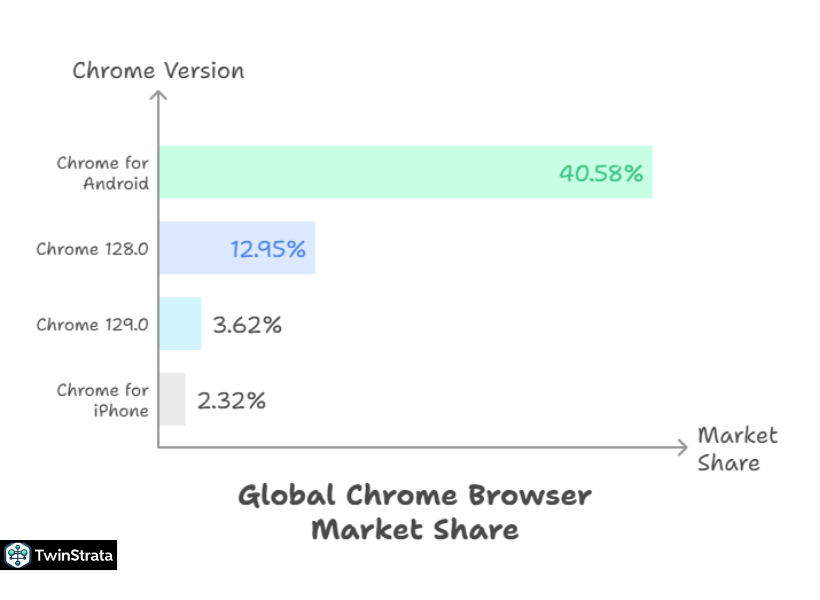
Different versions of Chrome cater to various operating systems and devices. Understanding their market share provides insight into where Chrome usage is concentrated.
Chrome for Android holds the largest share of the global browser market at 40.58%. This dominance underscores the immense popularity of Android devices worldwide and Chrome’s seamless integration within that ecosystem.
The second most widely used version is Chrome 128.0, accounting for 12.95% of the browser market share, representing a significant portion of desktop and other platform users.
Table: Most Popular Chrome Versions Worldwide
| Chrome Version | Browser Market Share |
| Chrome For Android | 40.58% |
| Chrome 128.0 | 12.95% |
| Chrome 129.0 | 3.62% |
| Chrome for iPhone | 2.32% |
What Users Are Asking: Latest Insights from Quora and Reddit
Beyond the raw statistics, the real-time pulse of user sentiment often comes from platforms like Quora and Reddit. Here’s what users are discussing about Chrome, offering a glimpse into emerging trends and concerns:
- Privacy Concerns and Alternatives: Many users are actively discussing Chrome’s data collection practices and looking for privacy-focused alternatives. While Chrome remains popular, the demand for more transparent data handling is a recurring theme. Questions about “de-Googled” browsers and VPN integrations are common.
- Performance on Older Hardware: Users frequently inquire about Chrome’s resource consumption, especially on older laptops or devices with limited RAM. Optimizing Chrome for speed and efficiency without upgrading hardware is a hot topic. Tips for managing extensions and reducing background processes are often shared.
- AI Integration and Features: The discussion around AI features within browsers is picking up. Users are asking about upcoming AI-powered tools in Chrome, such as enhanced search capabilities, content summarization, or even AI assistance for writing and coding directly within the browser.
- Customization Beyond Extensions: While extensions are popular, some users express a desire for more native customization options within Chrome’s interface itself, like deeper theme controls or more flexible tab management features built-in.
- Syncing Across Devices (and Security): As users increasingly work across multiple devices, seamless and secure syncing of bookmarks, history, and passwords is crucial. There’s always a discussion about the reliability and security of Chrome’s sync features.
These discussions highlight that while Chrome’s market share is strong, users are increasingly savvy and demand more from their browsing experience, focusing on privacy, performance, and advanced features.
FAQs About Google Chrome Statistics
1. Why is Google Chrome so popular compared to other web browsers?
Google Chrome is incredibly popular due to a combination of factors, including its speed, reliability, seamless integration with other Google services like Gmail and Google Drive, and a vast library of extensions that allow for extensive customization. Its user-friendly interface and consistent performance across various devices also contribute significantly to its widespread adoption.
2. How can I benefit from using Chrome extensions?
Chrome extensions are mini-programs that add new features and functionality to your browser, and you can benefit from them in numerous ways. They can enhance productivity by providing tools for task management, grammar checking, or note-taking; improve security with ad blockers and password managers; or even personalize your browsing experience with themes and accessibility features. Exploring the Chrome Web Store allows you to find tools tailored to your specific needs.
3. What are the main differences in Chrome's market share between desktop and mobile devices?
While Chrome dominates both desktop and mobile markets, its mobile market share (70.6% globally) is slightly higher than its desktop market share (71.17% globally). This is largely due to its default integration with the Android operating system, which powers a significant number of smartphones worldwide, making it the primary browser for many mobile users.
4. Are there any privacy concerns when using Google Chrome, and how can I address them?
Some users express privacy concerns regarding Chrome’s data collection practices, as Google is an advertising-driven company. To address these concerns, you can adjust Chrome’s privacy settings, use incognito mode for private browsing, install privacy-focused extensions like ad blockers and anti-tracking tools, or consider using a Virtual Private Network (VPN) to encrypt your internet traffic.
5. What new features or trends can we expect from Google Chrome in the near future?
In the near future, we can expect Google Chrome to continue focusing on enhanced security measures, improved performance, and deeper integration of artificial intelligence (AI) features for smarter browsing, content summarization, and personalized web experiences. There will also likely be ongoing improvements to cross-device syncing and further customization options to cater to diverse user preferences.
Also Read:
Conclusion:
Google Chrome truly continues to dominate both the mobile and desktop browser markets globally, reinforcing its position as the world’s most popular web browser. Its impressive 70.6% share in the mobile browser segment and a leading 71.17% share in the desktop market are clear indicators of its widespread adoption and user loyalty.
With a massive ecosystem of 111,933 extensions available on the Chrome Web Store, users have unparalleled opportunities to customize and enhance their browsing experience, with productivity extensions proving to be the most popular category.
Chrome’s continuous evolution, its robust security features (including its unique vulnerability reward program), and its consistent performance across devices are the cornerstones of its success.
As we move through 2025, Chrome isn’t just maintaining its lead; it’s actively expanding its user base and integrating new features. For individuals and businesses alike, understanding and leveraging Chrome’s capabilities remains essential for navigating the digital world efficiently and securely.
A futuristic, sleek Google Chrome logo glowing with digital light, surrounded by a subtle network of interconnected devices (smartphones, laptops, tablets) showcasing its widespread reach. The background is a soft, blurred image of a global digital map, emphasizing its worldwide dominance.
